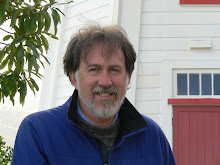Although this blog is not intended to be a travelogue, it inescapably involves physical travel as well as a changing healthcare environment. I had heard that the flight from the US West Coast to New Zealand is almost interminable. I’m here to report that it seemed slightly longer than that. (There is a reason that studies on immobilization and deep vein thrombosis have been performed on passengers flying this route!). Fortunately, I was able to do lots of stretching en route and I did not arrive with any coagulation problems, only some serious jetlag. Even that resolved relatively quickly, however, and when I finally was able to get outside and stretch my legs in earnest, I was greeted by an extraordinarily attractive cityscape bathed in glorious sunshine with temperatures in the 70s. I’ve heard it said before that travelers from the US find Wellington reminiscent of San Francisco with its clear maritime light, hilly bayside waterfront setting and--at least to this Midwestern hick--exotic flora such as palm trees. Wellington has all that and more. Add to this natural beauty a compact density imposed by its location and it’s clear that it’s a place that simply invites exploration on foot.
With a weekend to recover from my jet lag, I opted to do just that. While I was walking past a city hard at play, and enjoying intimate neighborhood street streetscapes I couldn’t help but reflect on the process of walking and its relation to health care. ( You knew I’d work back to this!) Walking is indicative of something vital that we’ve lost and is a potential solution to some of the ravages of the chronic diseases that are increasingly straining our ability to care for our fellow citizens. As with so many things in medicine, it’s really pretty simple: we don’t have wings; we don’t have fins; we are bipedal creatures designed to ambulate. Our entire physiology and structure have evolved for this purpose. And yet, like the obese skeletally atrophic humans many centuries in the future depicted in the recent movie Wally, we seem to be developing infrastructure that makes the exercise of this fundamental physiological skill set almost impossible. Of course the most conspicuous enemy of all is the automobile and the seductive convenience that it allows.In this new environment of left-handed driving an additional threat to life and limb is posed by the fact that every intersection and pedestrian crossing is a hazardous exercise in relearning some very basic pedestrian skills--like looking to the right, not the left when crossing. And as much as I have been telling myself to be very careful, I almost had an incident today that would have allowed me to get an intimate unwanted first-hand exposure to the New Zealand health system.
So even walking has its hazards in my current setting. But I do hope to not only walk as much as possible as a means of everyday transportation, I also hope to experience at least some of the legendary system of “tracks” (trails) that supports the popular NZ activity known as “tramping” (hiking to us).So I hope not only to meditate on walking as a simple preventative health intervention and as a metaphor for more rational health interventions overall, I hope also, if you’ll pardon the cliché, to simply walk the walk.
I may even get a little healthier myself.
Tomorrow starts my 3 day orientation into the NZ health system. We’ll see how it looks.


Walking
ReplyDeleteWell, I just plotted a course to walk in my neighborhood. Starting out with a little over a mile. I needed to become proactive with my own health because of an elevated blood pressure. The walking will help with the stress, winter weight gain, the over zealous dog and hopefully working on that high BP. A practical, simple, and affordable way to exercise. Wisconsin is not as beautiful as New Zealand, especially with that nasty dirty snow melting leading into the mud season, but spring is coming and soon the landscape will be bathed in green. I am fortunate to have a good health care system in place because of my employment. Working with at-risk adolescents, it is apparent that the have-nots continually are excluded from decent health care. The cycle of poverty and growing recession are finding more and more people without necessary care or having to make difficult decisions. The questions that you will be asking will surely get the conversation rolling and I look forward to hearing from you. Best wishes, enjoy yourself.